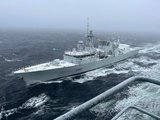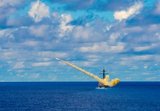Naval Warfare magazine: Aircraft carriers; European joint projects and more
What’s inside this edition:
Comment: Down, but not out
The sinking of the Russian Navy’s Black Sea flagship, although not evidence of a sea change in the naval domain, is a far cry from the pre-emptive self-sinking of Ukraine’s own flagship. Donation of increasingly advanced materiel demonstrates increased faith in Ukraine’s ability to resist the invasion.
Features include:
Vital asset or floating target? Aircraft carriers in the age of missiles
Aircraft carriers continue to be some of the most expensive and valuable tools in naval fleets. However, with the proliferation of new and advanced missiles creating A2/AD bubbles, the ships’ utility has been questioned.
MUUVing with the times: Seafloor threats drive UUV development
As concerns over seafloors becoming a new arena of warfare grow, navies are increasingly seeking systems capable of autonomous underwater operations. Companies are consequently stepping up to meet surging demand.
Enablers of power: Next-generation support ships
Behind every great navy, there is a great auxiliary. While destroyers and aircraft carriers are widely seen as the most powerful tools in a navy’s arsenal, ships that keep the fleet going are never far behind.
European joint projects: The complexities of collaboration on the old continent
Russia’s invasion of Ukraine has caused a re-evaluation of the European security landscape. The EU may politically join European nations, but its approach to defence lacks a similar unitarian approach. Shephard breaks down how and when member states work together on naval developments.
The inexorable rise of the Turkish naval industry
Turkey’s defence industry has made remarkable progress in the last few decades, being increasingly able to develop indigenous systems for domestic and international customers alike. But are these advances more evolution than revolution?
Protecting the North Atlantic: The surprise element
Russian threats of nuclear strikes on the capitals of Europe have resurfaced in the context of the invasion of Ukraine. Against this backdrop, the importance of ASW has been re-emphasised with particular focus on the North Atlantic.
Bonus content coming soon.
Read the edition here.
More from Naval Warfare
-
![NATO tests use of “undetectable, jam-proof” laser communication in maritime scenarios]()
NATO tests use of “undetectable, jam-proof” laser communication in maritime scenarios
As part of its effort to better prepare its capabilities for operations in contested and congested scenarios, NATO evaluated a Lithuanian ship-to-ship terminal designed to not be susceptible to enemy interference.
-
![US Navy advances with the Harpoon Service Life Extension Programme]()
US Navy advances with the Harpoon Service Life Extension Programme
The US Navy plans to improve Harpoon’s anti-ship and land attack capabilities by equipping the missiles with sensors and technologies required for succeeding in future battlespace.
-
![Future of the Canadian Patrol Submarine Project is still unclear]()
Future of the Canadian Patrol Submarine Project is still unclear
The Canadian government remains tight-lipped on the timeline and funding required for the next steps of its Canadian Submarine Patrol Project, which should offer improved capabilities for the country’s navy.






















